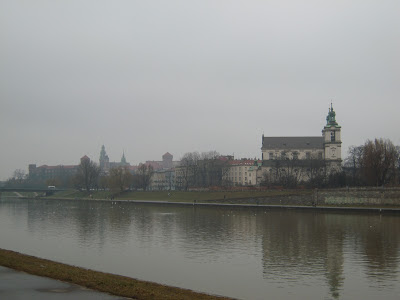Kościół Świéta Józefa, “St. Joseph’s,” was a bit of a surprise up close, though you can see the central spire from a distance, which drew me across the river in the first place. Actually, I had noticed it from the heights of the Zwierzyniec earlier in the week. On a sunny day, even a partly cloudy one, the entry grounds and the facade might have had the charm of a fairy tale, an effect that they did not have in the mist and murk of yesterday afternoon, so that while it did not positively charm, it still surprised. In a good way. Podgórze, you see, presents a bit roughly, grittily; not infrequent spots of dereliction, asymmetry, inaccessibility, hidden and uninviting accesses under construction whose completion you wonder about, and, little traffic, human or automotive, for a Saturday afternoon. Were they all in Kraków, shopping? On one side of the street you have a handsome early 1900s' church and seminary; on the other, a ruin in the making. I hope that was a ruin in the making, and not somebody’s domicile. But if it were, the inhabitants would interest me, or the previous inhabitants—not enough for me to knock on the door, of course—but, whatever Podgórze lacks, comparatively to Kraków, in beauties, it has its proportional weight in truth, gritty though it may be. Every place does. And while we need beauty to help us bear the grittiness, it is the truth, ultimately, that we have to bear.


 |
| Wawel Hill and St. Stanislaw from Podgorze |
